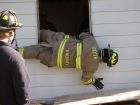
Back to Basics: Making a mayday call, part 3
By Mark van der Feyst
Features Fire Ground Training annex canadian firefighter trainingWhen firefighters call for a mayday, they are informing everybody that they need help. Whatever the situation may be, they are in need of assistance and the first step is to call a mayday.
When a mayday call is made, firefighters can initiate a few action steps to get out potentially life-threatening situations. Let’s examine four main action steps over the next four editions of
Canadian Firefighter that can be taken by the endangered firefighter if they are able. These four action steps are orientation, communication, alert command and activate PASS alarm.
Why these action steps? Firefighter survival is about rescuing yourself before the rapid intervention team (RIT) operation, if possible. If you can rescue yourself, it will negate the need for the RIT team to continue, allowing continued focus on fire ground operations.
Firstly, remain calm and don’t panic. This sounds very easy and may seem like common sense, but the reality is when a life-or-death death situation is staring you directly in the face, you could easily become another number in Canada’s line of duty death (LODD) statistics. This is a terrible situation to be in and it is common to panic. The flight or fight response is triggered as firefighters try to free themselves from dangerous situations.
Can a firefighter remain calm so they can rescue themselves or call a mayday? The answer is yes – yes, they can.
A firefighter with proper and consistent training can learn to remain calm when facing a life-or-death situation. For example, two Toronto firefighters fell from a roof into a burning building while battling a massive six-alarm blaze downtown in January 2011. The mayday call that was put out by the captain who fell into the fire was recorded on the dispatch audio. He was calm, cool and collected. His transmission was crystal clear with a calm voice. Why was this? He was trained to do so. He participated in firefighter survival training a few days before the fire, which helped him to remain calm when he faced this situation.
To successfully complete this self-rescue endeavour, the firefighter must get their bearings. This can be accomplished by scanning around the immediate area. By observing their surroundings, a firefighter may be able to pinpoint their location, which can be communicated to the RIT team. This allows the team to get to the downed firefighter quickly, which helps move rescue operation faster. What if the firefighter can’t see anything? We can always use our sense of touch to determine what part of a house or building we might be in.
Buildings and rooms have some common features that we can perceive through touch. For example, if you are on the second floor of a house and feel carpet, a bed or a dresser, it is safe to assume that you are in a bedroom. If you are on the second floor and there is a hard floor surface that feels slippery, you are most likely in a bathroom. On the first floor of a house, most kitchens have hard floor surfaces; family rooms often have some form of carpeting. When firefighters feel around the area where we are lying or sitting, we might be able to figure out where we are and orientate ourselves.
After we have determined where we are, we need to determine how much air we have left in the cylinder. This is important information that we need to pass on to command and the RIT team. By knowing how much air is left, a firefighter can start to conserve air and wait for the RIT team. If the supply is low, or if there is enough air, firefighters can start to self-rescue.
Houses typically have many windows, with at least one in every room. Whether you have low or high air supply, bailing out a window is a good option. Without using too much air a firefighter can accomplish a head-first ladder dive, hang and drop, or use a rope bailout system.
A firefighter can also try to locate a hose line. If a firefighter can locate a hose line, they can read the couplings by feeling for the lugs, which determines way is out by following the hose back to the pump panel.
Lastly, the firefighter who has called for a mayday needs to consider fellow crew members. Where are they? Firefighters work in teams with a minimum of two members. Depending on the time spent inside the structure, there may be more than one team operating inside. By locating a fellow crew member, the mayday firefighter can be led to safety or can be assisted in other ways, like using buddy breathing, EBSS hose, psychological support, or physical assistance in getting free from an entrapment.
Survival orientation training can be done at the fire station or training building. The training helps firefighters focus on the best self-preservation tactics and develop a calm mindset. Some tactics include assessing surroundings, checking air supply status and locating hose lines and fellow crew members. Training is crucial to survival. Train in firefighter survival so that if the time comes that you are facing a life-or-death situation, the outcome will be a positive, like it was for Toronto fire crews in 2011.
Mark van der Feyst has been in the fire service since 1999 and is a full-time firefighter in Ontario. He teaches in Canada, the United States and India and is lead author of Residential Fire Rescue. Mark@FireStarTraining.com
Print this page
Advertisement
- Dispatches: A lifetime of learning in 18 months
- Oakville Fire uses new software to maximize home safety surveys


